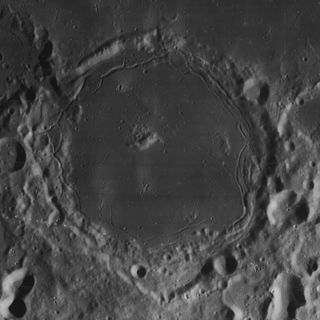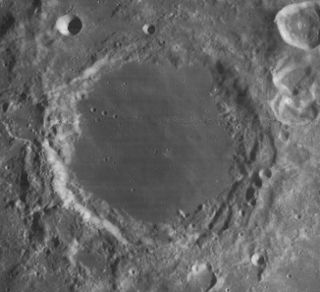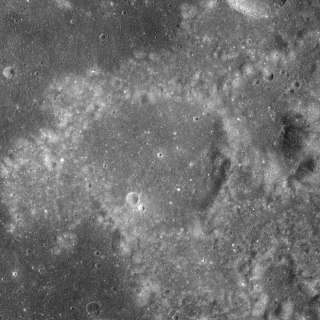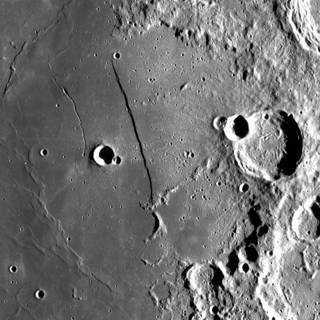
Mare Nubium is a lunar mare in the Nubium basin on the Moon's near side. The mare is located just to the southeast of Oceanus Procellarum.

Arzachel is a relatively young lunar impact crater located in the highlands in the south-central part of the visible Moon, close to the zero meridian. It lies to the south of the crater Alphonsus, and together with Ptolemaeus further north the three form a prominent line of craters to the east of Mare Nubium. The smaller Alpetragius lies to the northwest, and Thebit is to the southwest along the edge of the mare.

Hesiodus is a lunar impact crater located on the southern fringes of Mare Nubium, to the northwest of the crater Pitatus. It was named after the ancient Greek poet Hesiod. Starting near the northwest rim of Hesiodus is the wide cleft named Rima Hesiodus. This rille runs 300 km east-southeastward to the Palus Epidemiarum

Pitatus is an ancient lunar impact crater located at the southern edge of Mare Nubium. It was named after Italian astronomer Pietro Pitati by the IAU in 1935. Joined to the northwest rim is the crater Hesiodus, and the two are joined by a narrow cleft. To the south lie the attached Wurzelbauer and Gauricus.

Birt is a lunar impact crater located in the eastern half of the Mare Nubium and west of the Rupes Recta. It was named after British selenographer William R. Birt.

Deslandres is the heavily worn and distorted remains of a lunar impact crater. It is located to the southeast of the Mare Nubium, in the rugged southern highlands of the Moon. In dimension it is the third-largest crater formation on the visible Moon, being beaten only by Clavius and by the 303-kilometer-diameter walled plain Bailly. The northern and eastern parts of the floor display a relatively level surface, but it is pock-marked with numerous craters. There is a small region of mare material, due to basaltic lava, along the eastern interior floor.

Alpetragius is a lunar impact crater located on the eastern edge of Mare Nubium, to the southwest of the much larger crater Alphonsus. In the southeast is the prominent crater Arzachel, and to the west lies the flooded Lassell. Alpetragius is a Latinization of the name of Nur ad-Din al-Bitruji, a Spanish-Arab astronomer.

König is a lunar impact crater on the southwest Mare Nubium. It was named after Austrian mathematician and astronomer Rudolf König. It lies to the southwest of the prominent crater Bullialdus, and northwest of the flooded Kies. The rim of König is somewhat polygonal in outline, with a small outward bulge to the south and only a slight outer rampart. The crater interior is rough and irregular, with a negligible central peak. The material along the inner sides has slumped to the floor forming a ring of debris around the small central floor.

Endymion is a lunar impact crater that lies near the northeast limb of the Moon. It is located to the east of Mare Frigoris and north of Lacus Temporis. To the southwest is the somewhat smaller crater Atlas. Because of its location, Endymion has an oval appearance from foreshortening. Beyond the crater along the lunar limb is the Mare Humboldtianum.

Flammarion is a lunar impact crater on the south edge of Sinus Medii. Its diameter is 76 km. It is named after the French astronomer Camille Flammarion. It is located between the crater Mösting to the northwest and Herschel to the southeast. The bowl-shaped Mösting A intersects the western rim of Flammarion.

Mercator is a lunar impact crater that is located on the southwestern edge of Mare Nubium, in the southwest part of the Moon. It was named after 16th-century Southern Dutch cartographer Gerardus Mercator. It is located to the southeast of the crater Campanus, and the two are separated by a narrow, winding valley.

Agatharchides is a lunar impact crater located at the southern edge of Oceanus Procellarum, in the region between the Mare Humorum and Mare Nubium. To the east-southeast is the crater Bullialdus, and to the south-southwest lies Loewy. It is named after the Greek geographer Agatharchides.

Alfraganus is a small lunar impact crater that lies in the rugged highland region to the southwest of the Mare Tranquillitatis. It is named after the Arab Muslim astronomer Alfraganus. Northwest of Alfraganus is the crater Delambre, and to the south is the irregular Zöllner. The rim of Alfraganus is circular and retains a sharp edge that has not received a significant amount of wear due to subsequent impacts. The interior floor is roughly half the diameter of the crater rim.

Tempel is the remnant of a lunar impact crater whose outer rim has been eroded, indented, and reshaped by subsequent impacts and lava flows. It is attached to the eastern rim of the crater Agrippa, in an area that has been resurfaced by old lava flows. To the southwest is Godin, and to the east lies the small, bowl-shaped Whewell. Its diameter is 43 km. The crater was named after German astronomer Wilhelm Tempel.

Campanus is a lunar impact crater that is located on the southwestern edge of Mare Nubium. It was named after Italian astronomer Campanus of Novara. It forms a crater pair with Mercator just to the southeast. Along the southern rampart of Campanus is the small lunar mare named Palus Epidemiarum. To the southwest is the small crater Dunthorne.

Daubrée is a lunar impact crater that is located to the southwest of the Mare Serenitatis, just to the west-southwest of the crater Menelaus in the Montes Haemus range. The small lunar mare Lacus Hiemalis lies along the southwest rim of Daubrée. The crater was named after French geologist Gabriel A. Daubrée. It was previously designated Menelaus S.

Nichollet is a small, isolated lunar impact crater on the Mare Nubium, a lunar mare in the southwest quadrant of the Moon. It was named after French astronomer Joseph Nicollet. This crater is located to the north of the crater Pitatus, about midway between Wolf to the west and Birt to the east.

File: Franz is a small lunar impact crater identified during the Apollo mission in August 1971 and located along the eastern edge of the Sinus Amoris, a bay that forms a northern extension to the Mare Tranquillitatis. Its diameter is 25 km. It was named after German astronomer Julius Heinrich Franz. It lies to the southwest of the prominent crater Macrobius. To the north is the smaller Carmichael, and to the northwest is the diminutive Theophrastus.

Weiss is a lunar impact crater along the southern edge of the Mare Nubium. It was named after Austrian astronomer Edmund Weiss. Nearly attached to the southwest rim is the crater Cichus, and Pitatus lies just over one crater diameter to the east-northeast. To the east-southeast lies the eroded Wurzelbauer.

Rupes Recta is a linear fault on the Moon, in the southeastern part of the Mare Nubium at 22.1°S 7.8°W. The name is Latin for straight cliff, although it is more commonly called the Straight Wall. This is the most well-known escarpment on the Moon, and is a popular target for amateur astronomers.
























